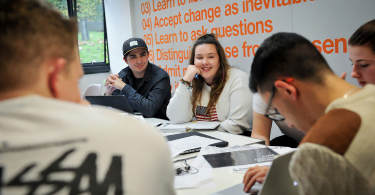For anyone working in the public eye, social media is always a difficult thing to balance. As a journalist, it’s tempting to go completely on lockdown so no one can access your profiles, but it’s also important to remain visible so you’re easy to contact regarding stories and also so you can be held accountable for the stories you write.
You should also be the ‘everyman’ – the eyes and ears of the public – rather than perceive yourself to be better than the people who use social media. The key is remaining professional and keeping some things private, while maintaining a sense of personality online. Here I will offer some tips on how to get started.
Twitter profile
For journalists, Twitter is the very first place to get started. It’s fantastic both for finding stories and getting yourself noticed in your network. As a local journalist I use it to interact with both readers and other reporters and find it very useful. Sign up and make sure you include a picture and bio, and follow a good mixture of high-profile journalists you aspire to be like, journalists in your field who do similar things to you who you’re likely to interact with, and accounts relevant to the stories you’re writing. For example, I work in local news, so I follow local people, accounts from the emergency services in the area and my competitors.
If you’re a student journalist you’d probably want to do similar, but if you have more of a niche such music journalism you may want to follow artists from a genre you’re interested in, including those from your local area who may be looking for coverage. Once you’re set up, log in to TweetDeck. It’s free and lets you view lots of different timelines
at once so you don’t miss anything. If you’re at a student magazine or paper, you could set up some lists to help you track the emergency services, politicians and students in separate columns. It also lets you tweet from multiple accounts.
…you can link your byline on your stories to your Facebook page, so people can click through to your page and contact you directly or view your other work. You can also link pages to Facebook groups. I not only post my own work on my Facebook page but post stories by my colleagues and other things which interest me.
After a few years, when you’ve built up your account to a good number of followers and it gets a lot of interaction, it can be useful for job hunting. Strangely enough I landed my first job after my editor contacted me on Twitter!
I have never been entirely sure how public to be with my Facebook profile, and if I’m honest, I feel like I’ve only properly cracked it in the last few months. Instead of having a public Facebook profile, I keep mine private for friends and family and have set up a public Facebook page instead. This means I can keep my work and personal life separate. I message people for work from my page and post all my stories on there, and have invited all my Facebook friends to like the page. This means they only see my work updates if they want to, and I can manage a public profile where I decide what my readers see, leaving my private life on my private profile.

There is a lot of functionality with pages too, now – you can link your byline on your stories to your Facebook page so people can click through to your page and contact you directly or view your other work. You can also link pages to Facebook groups. I not only post my own work on my Facebook page but post stories by my colleagues and other things which interest me. It helps me interact with readers on a more personal level.
LinkedIn profile
LinkedIn isn’t for everyone. I don’t use it on a day-to-day basis but would recommend you set one up anyway. It’s a great way to put your CV online, as LinkedIn ranks highly on Google, so if someone searches for you, your profile is likely to appear alongside your Twitter profile (if you’re lucky enough to
have an unusual name, anyway!). It can be time-consuming to set up, as there are lots of sections to fill in, but LinkedIn guides you through the process and it’s easy to do. You can also upload a document of your CV if you wish. Once you’re set up, you can add ‘connections’ – similar to Facebook friends – and connect with people in your field. You can also use LinkedIn for job searching and recruiters may get in touch.
Portfolio
Finally, one of the most important parts of your public profile is your portfolio, as it’s your chance to show off your work. There are many different websites you could use, so make sure you do your research first, but ones I have used or my friends have used include Contently, Clippings.me, Muck Rack, WordPress and Journo Portfolio. Just make sure you keep it updated and link it to your Twitter and Facebook accounts so people could find it.
Need some social media advice? Feel free to contact me on:
sian@kettlemag.co.uk
or tweet me at @SianElvin










